Patellar Tracking Disorder: Exercises
Overview
The thigh muscles (quadriceps) help keep the kneecap (patella) stable and in place. Weak quadriceps increase the risk of patellar tracking disorder.
Ligaments and tendons also help stabilize the patella. If these are too tight or too loose, you have a greater risk of patellar tracking disorder.
The goals of nonsurgical treatment of patellar tracking problems are to reduce symptoms, increase quadriceps strength and endurance, and return to normal function. Exercises for patellar tracking disorder are not complicated and can be done at home in about 20 minutes a day.
- Most patellar tracking problems can be treated effectively without surgery. Nonsurgical treatment may include rest, regular stretching and strengthening exercises, taping or bracing the knee, using ice, and short-term use of nonsteroidal anti-inflammatory drugs (NSAIDs).
- Quadriceps strengthening is the most commonly prescribed treatment for patellar tracking disorder. Exercises to increase flexibility and to strengthen the muscles around the hip can also help.
Your doctor or physical therapist (PT) will help you decide what exercises to do. You will likely start with one or two exercises and do more over time. Your PT may use biofeedback during some exercises to help you learn to contract certain muscles, especially the inner muscle of your quadriceps.
Things to keep in mind
- Correct diagnosis is important in designing an exercise or rehabilitation program. The treatment you receive and the exercise program you use to rehabilitate your knee should be developed specifically for your condition.
- At first, following an injury or a flare-up of symptoms of patellar tracking disorder, knee activity should be reduced. Overuse and trauma are common causes of knee pain. And resting your knee will help relieve pain. Exercises should begin as the symptoms resolve.
- Some doctors will recommend using a brace or a taping technique to keep your kneecap in proper alignment, in addition to an exercise program. Be sure to closely follow the instructions from your doctor or physical therapist.
- Be sure to stay on your exercise program. You may not notice much improvement in your symptoms right away, and recovery can take several months. This can be frustrating. Problems can come back if you don't keep your strength and flexibility.
How do you do the exercises?
First exercises
Quad set

- Sit or lie down on a firm surface or the floor with your affected leg straight. Place a small, rolled-up towel under your knee.
- Tighten the thigh muscles of your straight leg by pressing the back of your knee down into the towel.
- Hold for about 6 seconds, then rest.
- Repeat 8 to 12 times.
- It's a good idea to repeat these steps with your other leg.
Wall sit with ball squeeze
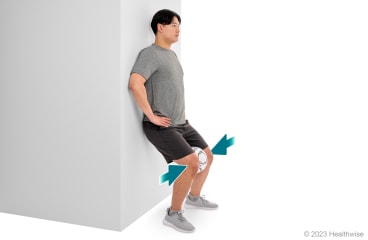
- Stand with your feet about hip-width apart and 12 inches from a wall.
- Lean against the wall and slide down until your knees are bent about 20 to 30 degrees.
- Place a ball about the size of a soccer ball between your knees and squeeze your knees against the ball for about 6 seconds.
- Rest a few seconds, then squeeze again.
- Repeat 8 to 12 times.
More intense exercises
Hip flexion (lying down, leg straight)
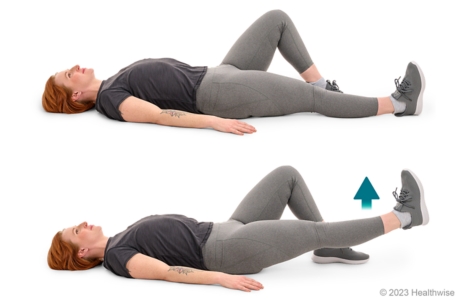
- Lie on your back with your affected leg straight. You can bend your other leg, if that feels more comfortable.
- Tighten the thigh muscles in your affected leg by pressing the back of your knee down. Hold your knee straight.
- Keeping the thigh muscles tight and your leg straight, lift your affected leg up so that your heel is about 12 inches off the floor. Hold for about 6 seconds, then lower slowly.
- Repeat 8 to 12 times.
- It's a good idea to repeat these steps with your other leg.
Hip adduction (lying on side)
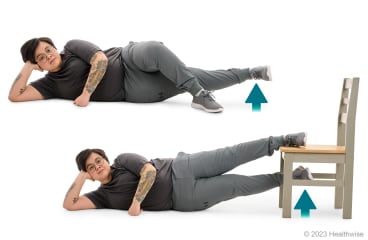
- Lie on your side with your affected leg on the floor.
- You can either prop your other leg on a chair, or you can bend that knee and put that foot in front of your other knee.
- Keep your knee straight and your leg in a straight line with your body.
- Lift your bottom leg up toward the ceiling about 6 inches. Hold for about 6 seconds, then lower slowly.
- Repeat 8 to 12 times.
- It's a good idea to repeat these steps on your other side.
- Keep your kneecap pointing forward.
- Don't let your hip drop back.
Hip abduction (lying on side)
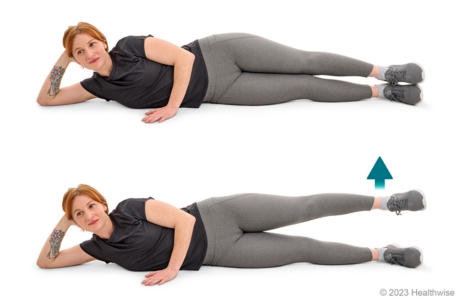
- Lie on your side, with your affected leg on top. You can use your hand or a pillow to support your head.
- Keep your knee straight and your leg in a straight line with your body.
- Lift your affected leg straight up toward the ceiling, about 12 inches off the floor. Hold for about 6 seconds, then slowly lower your leg.
- Repeat 8 to 12 times.
- It's a good idea to repeat these steps on your other side.
- Keep your kneecap pointing forward.
- Don't let your hip drop back.
Hip extension (lying down, leg straight)

- Lie on your stomach with your legs straight.
- Keeping your leg straight, lift the toes of your affected leg about 6 inches off the floor.
- Hold for about 6 seconds and then slowly lower your leg.
- Repeat 8 to 12 times.
- It's a good idea to repeat these steps with your other leg.
Shallow standing knee bend

- Stand with your hands lightly resting on a counter or chair in front of you. Put your feet shoulder-width apart.
- Slowly bend your knees so that you squat down like you're going to sit in a chair. Make sure that your knees don't go in front of your toes.
- Lower yourself about 6 inches. Your heels should stay on the floor at all times.
- Rise slowly to a standing position.
- Repeat 8 to 12 times.
Lateral step-up
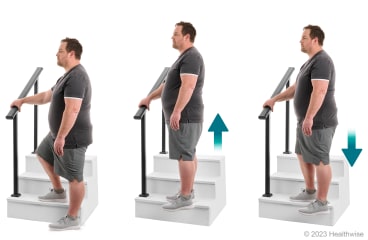
- Stand sideways on the bottom step of a staircase with your affected leg on the step and your other foot on the floor.
- Keeping your head up and your back straight, lean slightly forward. Hold on to a handrail or wall if you feel unsteady.
- Use your affected leg to raise yourself up, bringing your other foot level with the stair step. Then slowly bend your knee to lower your foot back down. As you bend and straighten your leg:
- Repeat 8 to 12 times.
- It's a good idea to repeat these steps with your other leg.
- Keep your hips level.
- Keep your knee moving in a straight line with your middle toe. Don't let your knee go past your toe.
- Keep your heel flat on the step.
Quad stretch (standing)
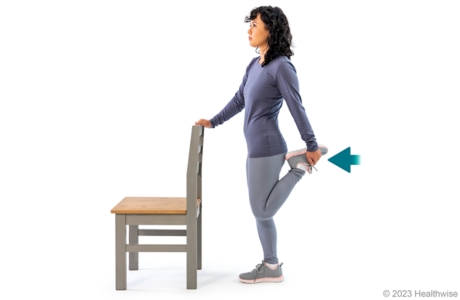
- If you are steady on your feet, stand while holding onto a chair or counter or while resting your hand on a wall. You can also lie on your stomach or your side to do this exercise.
- Bend the knee of the leg you want to stretch, and then reach back with the hand on the same side and grab the front of your foot. For example, if you're stretching your right leg, use your right hand.
- Keeping your knees next to each other, pull your foot toward your buttock until you feel a gentle stretch across the front of your hip and down the front of your thigh. Your knee should be pointed directly to the ground, not out to the side.
- Hold the stretch for at least 15 to 30 seconds.
- Repeat 2 to 4 times for each leg.
Hamstring stretch in a doorway
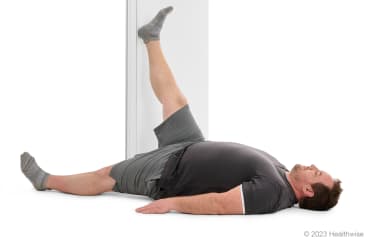
- Sit on the floor close to a doorway. Be sure to stretch your affected leg first.
- Lie down with your other leg through the doorway.
- Slide your affected leg up the wall to straighten your knee. Don't point your toes. You should feel a gentle stretch down the back of your leg. Be sure to:
- Hold the stretch for at least 1 minute. Then over time, try to lengthen the time you hold the stretch to as long as 6 minutes.
- Repeat 2 to 4 times.
- It's a good idea to repeat these steps with your other leg.
- To stretch your right leg, scoot to the right side of the doorway.
- To stretch your left leg, scoot to the left side of the doorway.
- Keep both knees straight.
- Keep your back flat and your other heel on the floor.
If you do not have a place to do this exercise in a doorway, there is another way to do it:
- Lie on your back, and bend the knee of your affected leg.
- Loop a towel under the ball and toes of that foot, and hold the ends of the towel in your hands.
- Straighten your knee as you raise that foot into the air. Slowly pull back on the towel. You should feel a gentle stretch down the back of your leg.
- Hold the stretch for 15 to 30 seconds. Or even better, hold the stretch for 1 minute if you can.
- Repeat 2 to 4 times.
- It's a good idea to repeat these steps with your other leg.
Hip internal rotator stretch
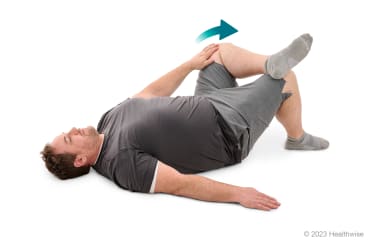
- Lie on your back with both knees bent and your feet flat on the floor.
- Put the ankle of your affected leg on your opposite thigh near your knee.
- Use your hand to gently push your knee away from your body until you feel a gentle stretch around your hip.
- Hold the stretch for 15 to 30 seconds.
- Repeat 2 to 4 times.
- It's a good idea to repeat these steps with your other leg.
Iliotibial band and buttock stretch
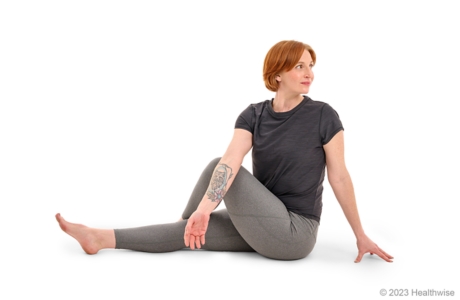
- Sit on the floor with your legs out in front of you.
- Bend the knee of your affected leg, and put that foot on the floor on the outside of the opposite leg. (Your legs will be crossed.)
- Twist your shoulders toward your bent leg, and put your opposite elbow on that knee.
- Push your arm against your knee to feel a gentle stretch at the back of your buttock and around your hip.
- Hold the stretch for at least 15 to 30 seconds.
- Repeat 2 to 4 times.
- It's a good idea to repeat these steps with your other leg.
Calf stretch (back knee straight)
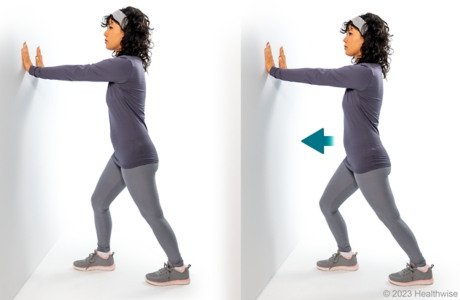
- Stand facing a wall with your hands on the wall. You can also do this with your hands on the back of a chair, a counter, or a tree.
- Put one leg about a step behind your other leg, with your toes pointing forward.
- Keeping your back leg straight and your back heel on the floor, bend your front knee and gently bring your hip and chest toward the wall until you feel a stretch in the calf of your back leg.
- Hold the stretch for 15 to 30 seconds.
- Repeat 2 to 4 times for each leg.
Credits
Current as of: July 31, 2024
Author: Ignite Healthwise, LLC Staff
Clinical Review Board
All Healthwise education is reviewed by a team that includes physicians, nurses, advanced practitioners, registered dieticians, and other healthcare professionals.
Current as of: July 31, 2024
Author: Ignite Healthwise, LLC Staff
Clinical Review Board
All Healthwise education is reviewed by a team that includes physicians, nurses, advanced practitioners, registered dieticians, and other healthcare professionals.

